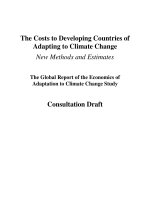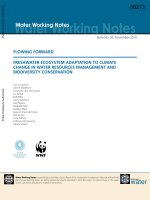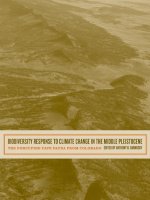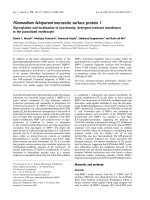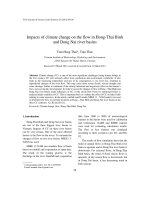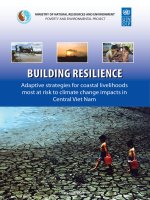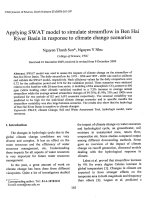Awareness and vulnerability to climate change among coastal communities in ghana
Bạn đang xem bản rút gọn của tài liệu. Xem và tải ngay bản đầy đủ của tài liệu tại đây (7.77 MB, 171 trang )
MINISTRY OF EDUCATION AND TRAINING
NHA TRANG UNIVERSITY
SARFO ISAAC
AWARENESS AND VULNERABILITY TO CLIMATE CHANGE AMONG
COASTAL COMMUNITIES IN GHANA: THE CASE OF DANSOMAN IN THE
GREATER ACCRA REGION.
MASTER THESIS
KHANH HOA, 2018.
MINISTRY OF EDUCATION AND TRAINING
NHA TRANG UNIVERSITY
SARFO ISAAC
AWARENESS AND VULNERABILITY TO CLIMATE CHANGE AMONG
COASTAL COMMUNITIES IN GHANA: THE CASE OF DANSOMAN IN THE
GREATER ACCRA REGION.
MASTER THESIS
Marine Ecosystem Management and
Climate Change
Major
Topic allocation Decision
Decision on establishing the Committee:
Defense date:
Supervisors: Professor Peter Arbo
Dr. Le Kim Long
Chairman:
Prof. Nguyen Thi Kim Anh
Faculty of Graduate Studies:
Hoang Ha Giang
KHANH HOA – 2018
03-10 June, 2018
DECLARATION
I hereby declare that this master thesis is the result of research work carried out by myself under
this Norhed master’s degree training program at Nha Trang University in collaboration with
University of Tromso (The arctic University of Norway), University of Bergen in Norway and
University of Ruhuna, Sri Lanka, within the confines of the Graduate School, Department of
Environment, fisheries and Biotechnology under the supervision of Professor Peter Arbo
(University of Tromso, Norway) and Dr. Le Kim Long (Nha Trang University, Vietnam). Except
for references cited, which serve as sources of secondary information (for which I have duly
acknowledged), it is not a reproduction in part, or in whole of any work ever presented for the
award of a degree. I am therefore responsible for any omissions, errors of reasons and presentation
of due facts.
………Date 02 Month May year 2018
Sarfo Isaac
I
DEDICATION
Glory and thanks be to God Almighty!
This thesis is dedicated to my lovely and supportive father, Mr. Isaac Akwasi Annor whose
financial support, guidance, care and motivation saw me through up to this level.
II
ACKNOWLEDGEMENT
My sincerest appreciation, with all humility, goes to all and sundry who contributed to making this
masters research a reality. With a joyful heart, wish to give special thanks to my father, Mr. Isaac
Akwasi Annor, who supported me whole heartedly towards the accomplishment of this academic
goal. Having braved all odds, wish to ask for God’s blessings for my father and other family
members who made this a reality. I wish to put on record the immense help I received from both
Universities, thus, University of Tromso, Norway and Nha Trang University, Vietnam whose
training and financial support (Norhed/Norad) broadened my scope of knowledge. To my good
friends, Mr. Henry Otchwemah Bortey, Mr. George Squire and Mr. Emmanuel Kedjanyi for their
support during the course of data collection and analysis.
I am also grateful to my unflagging lecturers at NTU and the supervisory team, Professor Peter
Arbo (University of Tromso, Norway) and Dr. Le Kim Long (Nha Trang University, Vietnam)
who patiently and meticulously, supervised this work and without whose comments and guidance,
this study would not have been possible. I wish to express my utmost gratitude to Dr. Eric Twum
(CEO of Institute of Green Growth Solutions, Ghana), Dr. Edward Nunoo (Head of Department,
Environment & Development Studies, Central University, Ghana) and Mrs. Memuna Mattah
(Lecturer, Department of Environment & Development Studies, Central University, Ghana) for
their guidance and motivation. To Ablekuma West District Assembly, National Disaster &
Management Organization, Environmental Protection Agency, Institute of Green Growth
Solutions, Premix Fuel Dealers Association in Dansoman as well as Dansoman Traditional council
I say kudos.
……………. Date 02 Month May
Sarfo Isaac
III
Year 2018
TABLE OF CONTENTS
DECLARATION .................................................................................................................. I
DEDICATION.................................................................................................................... II
ACKNOWLEDGEMENT ................................................................................................. III
TABLE OF CONTENTS .................................................................................................. IV
LIST OF TABLES.......................................................................................................... VIII
LIST OF FIGURES ........................................................................................................... IX
LIST OF PLATES .............................................................................................................. X
LIST OF ABBREVIATIONS ........................................................................................... XI
ABSTRACT ................................................................................................................... XIII
CHAPTER ONE .................................................................................................................. 1
1.1
Background ............................................................................................................... 1
1.2
Research Problem ...................................................................................................... 2
1.3
Aim of the Study ....................................................................................................... 4
1.4
Objectives of the study .............................................................................................. 4
1.4.1
1.5
Research Questions ................................................................................................ 4
Justification of the study............................................................................................ 5
CHAPTER TWO ................................................................................................................. 5
LITERATURE REVIEW .................................................................................................... 6
2.1
Climate Change: A Global Point of View ................................................................. 6
2.2
Synthesis of IPCC’s fifth Assessment report ............................................................ 6
2.2.1
Global Climate Change Projections: Expectations ................................................ 8
2.2.2
Climate Change responses ..................................................................................... 9
2.2.3
Climate Change Awareness at the Global Level ................................................. 10
2.2.4
African States Climate Change Learning Action plans ....................................... 11
2.3
Determinants of Climate Vulnerability ................................................................... 12
2.4
Climate change and coastal communities ............................................................... 14
IV
2.4.1
Physical changes .................................................................................................. 14
2.4.2
Ecosystem and bio-diversity changes .................................................................. 15
2.4.3
Socio-economic changes ...................................................................................... 15
2.4.4
Responses to Climate Change hazards ................................................................ 16
2.5
Social Vulnerability & Social Capital ..................................................................... 16
2.5.1
Social vulnerability .............................................................................................. 16
2.5.2
Concept of Social Capital .................................................................................... 18
2.6
Strategies to reduce Climate risks and vulnerability ............................................... 19
2.6.1
Concept of Adaptation ........................................................................................ 20
2.6.2
Traditional Knowledge: an adaptive capacity tool .............................................. 22
2.7
2.7.1
Measuring Effectiveness and sustainability of Climate Change adaptive strategies
22
The no regret strategy approach ........................................................................... 22
2.7.1.1 Case of Nador and Berkane in Morocco .............................................................. 23
2.8
Constraints to Adaptation ........................................................................................ 24
2.8.1
Physical Constraints ............................................................................................. 25
2.8.2
Economic and Financial Constraints ................................................................... 26
2.8.3
Social and cultural constraints ............................................................................. 26
2.8.4
Governance and Institutional Constraints ............................................................ 27
2.8.5
Biological/Ecological Constraints ....................................................................... 28
CHAPTER THREE ........................................................................................................... 31
GENERAL METHODOLOGY AND DATA................................................................... 31
3.1
Research Strategy .................................................................................................... 31
3.1.1
Qualitative research.............................................................................................. 31
3.1.2
Quantitative research............................................................................................ 32
3.2
Study Design ........................................................................................................... 32
3.3
Source of Data ......................................................................................................... 33
3.3.1
Focus Group Discussions (FGDs) ....................................................................... 33
3.3.2
Household and Institutions: Questionnaire Interviews ........................................ 34
3.4
Sampling Size .......................................................................................................... 36
V
3.4.1
Sampling Methodology ........................................................................................ 39
3.5
Data Analysis and Presentation ............................................................................... 40
3.6
Challenges/Limitations of the study ........................................................................ 40
CHAPTER FOUR ............................................................................................................. 42
STUDY AREA AND RESPONDENTS ........................................................................... 42
4.1
Social and demographic characteristics .................................................................. 42
4.1.1
Greater Accra Region........................................................................................... 42
4.1.2
Physical Characteristics of Accra ........................................................................ 43
4.1.3
Dansoman............................................................................................................. 43
4.1.3.1 The Traditional Authority .................................................................................... 44
4.1.3.2 The Political Authority (Local Government system) ............................................ 44
4.2 Social and demographical characteristics of informants ............................................. 46
CHAPTER FIVE ............................................................................................................... 56
LEVEL OF AWARENESS AND KNOWLEDGE ON CLIMATE CHANGE ............... 56
5.1 Climate Awareness and Knowledge ............................................................................ 56
5.1.1 Level of Climate Awareness .................................................................................... 56
5.1.2 Level of knowledge .................................................................................................. 59
5.2 Scale of attention and commitment ............................................................................. 60
5.3 Potential impacts of climate change in Dansoman ...................................................... 63
5.4 Local adaptation strategies in Dansoman. ................................................................... 66
5.4.1
Sea defence systems ............................................................................................ 68
5.4.2
National Sanitation Day ....................................................................................... 69
5.4.3 Distribution of waste bins ......................................................................................... 70
5.4.4
5.5
Awareness creation and capacity building ........................................................... 70
Self-Protective measures initiated by individual households in the study area ...... 71
5.6 Discussion .................................................................................................................... 73
VI
CHAPTER SIX.................................................................................................................. 75
EFFECTIVENESS AND SUSTAINABILITY OF LOCAL ADAPTATION
STRATEGIES IN DANSOMAN. ..................................................................................... 75
6.1 Identified stakeholders ................................................................................................. 75
6.1.1 Roles of identified stakeholders within the study area ............................................. 76
6.2 Institutional aid offered to affected communities in the study area-climate hazards .. 78
6.3
Effectiveness of local climate change adaptation strategies in Dansoman. ............ 81
6.4 Reactive and anticipatory measures ............................................................................ 85
6.4.1 Short-term (reactive) measures or strategies ............................................................ 85
6.4.2 Long (Anticipatory) term measures.......................................................................... 85
6.5
Discussion ............................................................................................................... 89
CHAPTER SEVEN ........................................................................................................... 92
SUMMARY, CONCLUSION AND RECOMMENDATIONS ....................................... 92
7.1 Summary and Conclusion ............................................................................................ 92
7.2
Strengths and weaknesses ....................................................................................... 94
7.2.1
Strengths............................................................................................................... 95
7.2.2
Weaknesses .......................................................................................................... 96
7.3 Recommendations ....................................................................................................... 96
REFERENCES .................................................................................................................. 99
APPENDICES .................................................................................................................... A
1.0 APPENDIX I ................................................................................................................ A
1.1 APPENDIX II ............................................................................................................... G
PLATES.............................................................................................................................. II
VII
LIST OF TABLES
Table4.1 Occupational status of respondents.................................................................................57
Table5.1Have you heard about Climate change?............................. .............................................61
Table5.2Have you heard about Climate change?.............................. ............................................61
Table5.3How did you get to know about Climate change?............... ...........................................62
Table5.4How did you get to know about Climate change?........ ...................................................63
Table5.5How serious is climate change at the global level?............. ............................................66
Table5.6How serious is climate change at the local level?........................................... ................67
Table5.7How serious is climate change at the global level?................................................. ........67
Table5.8How serious is climate change at the local level?................................................ ...........68
Table 5.9 Do you know of any local adaptation strategy initiated by the local assembly or any
private entity?.................................................................................................................................70
Table 5.9.1 Do you know of any local adaptation strategy initiated by the local assembly or any
private entity?.................................................................................................................................71
Table 5.9.2 Some adaptation strategies initiated by the central government through Ablekuma
West District Assembly and other private entities in Dansoman…………. .................................72
Table 6.1 Institutional Assistance offered to affected communities in Dansoman…....................84
Table 6.2 Case scenario of Nador-Berkane in Morocco and Dansoman in Accra, Ghana... .........86
Table 6.3 Interventions and other risk-reduction vulnerability strategy check in the study
area…. ............................................................................................................................................88
Table 6.4 Local residents’ assessment on adequacy of socio-economic parameters in the
area................................................ .................................................................................................91
Table 6.5Officials’ assessment on adequacy of socio-economic parameters in the area?
……………………………………………………………………………....................................92
Table 6.6.Local residents’ assessment on the effectiveness of institutions in carrying out their
functions...................................................................................... ...................................................92
Table 6.7.Officials’ assessment on the effectiveness of institutions in carrying out their
functions.................................................................... .....................................................................93
Table 6.8. Local residents’ assessment on effectiveness and sustainability of climate change
adaptation strategies in the area............................................................. ........................................94
Table 6.9 Officials’ assessment on effectiveness and sustainability of climate change adaptation
strategies in the area......................................................................... ..............................................94
VIII
LIST OF FIGURES
Figure 2.1 Determinants of vulnerability (Over lapse of vulnerability components) ....................15
Figure 2.2 Units of Analysis for Vulnerability Assessment and Adaptation .................................21
Figure2.3 Key Adaptation constraints to climate change ..............................................................28
Figure 2.4 Conceptual Framework of Vulnerability and Adaptation to Climate Change
impacts ...........................................................................................................................................32
Figure4.1Map of Dansoman illustrating the study area…………………………………………. 49
Figure4.2Satellite Map of Dansoman and the study area .............................................................50
Figure4.3Proportion of Gender for local residents ........................................................................51
Figure 4.4 Proportion in terms of Gender for officials .................................................................52
Figure 4.5 Age limit of local residents...........................................................................................53
Figure 4.6 Age Limit of Officials .................................................................................................54
Figure4.7Educational status of local residents..............................................................................55
Figure4.8Educational Status of Institutional Personnel ................................................................56
Figure4.9Length of stay of local residents in the study area .........................................................58
Figure4.10Duration of work (in years) for institutional personnel… ............................................59
Figure 5.1 Mode of Climate Information Dissemination & Communication ................................63
Figure 5.2Current and potential impacts of Climate Change in Dansoman ................................69
Figure5.3 Self-protective measures initiated by individuals along the coast of Dansoman .........76
Figure6.1Some identified stakeholders in climate adaptation and awareness. ..............................81
Figure6.2Institutional Framework ................................................................................................85
IX
LIST OF PLATES
Plate 3.1 Community leaders and key members of pressure groups in a Focus Group
Discussion.. ....................................................................................................................................40
Plate 3.2 Member of the traditional council in Dansoman being
interviewed…………………… .....................................................................................................41
Plate 3.3 Some local residents interviewed in the study
area…………………………………….. .......................................................................................41
Plate 3.4 Some fishing folks engaged during the course of data
collection………………………. ...................................................................................................42
Plate 3.5 Some fishing folks engaged during the course of data
collection………………...…….. ...................................................................................................42
Plate 5.1 Sea Defense System along the coast of
Dansoman……………………………………... ...........................................................................72
Plate 5.2 Sea Defense under extension long the coast of
Dansoman……………………………... .......................................................................................73
Plate 5.3 Stagnant water resulting from water splashed from the sea behind sea
defense…...…… ............................................................................................................................73
Plate 5.4 and plate 5.5 Households close to the sea along the coast of Dansoman being affected
by coastal inundation ...................................................................................................................157
Plate 5.6 Glefe Assembly member in the picture showing how the sea broke down this
wall…... ........................................................................................................................................157
Plate 5.7 Image of Chemu lagoon filled with plastic waste close to the coast of
Dansoman…….. ..........................................................................................................................158
Plate 6.1 and 6.2 Group photograph during and after holding a focus group
discussion………..... ......................................................................................................................84
Plates 6.3 Images showing some choked drainage systems in the study
area…………………….. ...............................................................................................................98
Plates 6.4 and 6.5 Images showing some choked drainage systems in the study
area…………….. ...........................................................................................................................99
X
LIST OF ABBREVIATIONS
AMCEN
African Ministerial Conference on Environment
AU
African Union
AfDB
Africa Development Bank
AR
Assessment Report
AMA
Accra Metropolitan Assembly
CBOs
Community Based Organizations
CC
Climate Change
CCEE
Climate Change and Environmental Education
CFCs
Chlorofluorocarbons
COP
Conference of the Parties
DCE
District Chief Executive
DRR
Disaster Risk Reductions
EbA
Ecosystem based Approach
EPA
Environmental Protection Agency
ESD
Education for Sustainable Development
FBOs
Faith Based Organizations
FGD
Focus Group Discussion
GoG
Government of Ghana
GHGs
Greenhouse Gases
GSS
Ghana Statistical Service
Gt
Gigatonne
HFA
Hyogo Framework for Action
IGGS
Institute of Green Growth Solutions
ILGS
Institute of Local Government Studies
IIED
International Institute for Environment and Development
IPCC
Intergovernmental Panel on Climate Change
IUCN
International Union for Conservation of Nature
XI
LULUCF
Land-use and Land-use change and Forestry
MEST
Ministry of Environment, Science, Technology
MESTI
Ministry of Environment, Science, Technology and Innovation
MMDAs
Metropolitan Municipal and District Assemblies
MOC
Ministry of Communication
NADMO
National Disaster and Management Organization
NCCAS
National Climate Change Adaptation Strategy
NCCP
National Climate Change Policy
NGOs
Non-Governmental Organizations
ODA
Overseas Development Assistance
PRA
Participatory Rural Appraisal
RECS
Regional Economic Communities
SPSS
Statistical Package for Social Sciences
TAR
Third Assessment Report
UN
United Nations
UKCIP
UK Climate Impact Programme
UNCCD
United Nations Convention to Combat Desertification
UNCED
United Nations Conference on Environment and Development
UN DESD
United Nations Decade of Education for Sustainable Development
UNDP
United Nations Development Programme
UNECA
United Nations Economic Commission for Africa
UNESCO
United Nations Education, Science and Cultural Organization
UNFCCC
United Nations Framework Convention on Climate Change
XII
ABSTRACT
Over the years, policy-makers, development-practitioners, international organizations and
academic scholars have taken stern initiatives to tackle climate change issues. Various climate
change adaptation policies and action plans have been formulated and implemented. This study
sought to determine the level of awareness and knowledge among households and officials in
Dansoman, an area within the city of Accra, Ghana and also to assess the effectiveness and
sustainability of initiated adaptation strategies. The study used descriptive statistics based on
informants’ observation and experience along with the “no-regret strategy” concept in assessing
the effectiveness and sustainability of local adaptation strategies. Assessing the effectiveness of
strategies are key components of monitoring and evaluation process, often overlooked after
implementation of policy-frameworks, hence, the need for this study. Findings show high level of
climate awareness among respondents but low level of knowledge on climate change issues and
need for collective efforts through environmental measures, in regulating human activities
impacting on prevailing climate. Methodologies assembled based on informants’ experience and
assessment show climate change adaptation strategies in the study area are not effective and
sustainable. This study serves as a baseline print for relevant stakeholders on critical areas which
needs attention. The study will inform decision on development in the area through an integrated
approach, which will reduce people’s vulnerability to climate hazards.
XIII
CHAPTER ONE
1.1
Background
Vulnerability and adaptation involve the management of risks posed by climate change.
Identifying key issues which stem a particular geographical area in the context of climate
change events aid in the formulation, implementation and evaluation of adaptive strategies
(Downing et.al, 2005). The concept of vulnerability assessment is significant in giving a
comprehensive knowledge and guidance on future risks, taking a stead look at both past and
current trend of events to inform decision making. The Intergovernmental Panel on Climate
Change (IPCC) in its fifth assessment report highlighted the changing climate in Africa and its
sub-regions. Temperatures across West Africa have risen over the last fifty (50) years with
fewer cold days and nights and prolonged warm days and nights between 1970 and 2010 (IPCC,
2014).Such impacts have been attributed to natural and human induced factors. The latter being
the main cause of recent trends due to increasing rate of greenhouse gas emissions mostly by
the developed countries with severe implications on developing countries (IPCC, 2007).
Among these impacts are evidence of single large scale events ranging from droughts, storms,
higher frequency and untimely precipitation, sea level rise causing floods and shortage in fresh
water resources.
Most countries in Africa classified as least developed are considered as most vulnerable groups
with limited resources and capacity to cope or adapt to any extreme weather event. Out of about
thirty (31) countries classified as most vulnerable, twenty-two (22) of these countries are in
Africa (Khattabi and Jobbins, 2011). The world and its current state is deemed age-ofanthropocene as most changes observed are significantly attributed to human induced factors
with unprecedented events occurring time over time. Over the past few decades and in recent
years, Ghana has experienced a number of climate change events. Among these are droughts,
flooding in major cities and sea level rise affecting most low-lying coastal communities in its
coastal belt (Appeaning et.al, 2011). These impacts have caused significant losses in both the
economic and energy sector in terms of food security and power supply, destruction of personal
properties and public infrastructure, disease outbreaks, loss of lives and displacement of people
from their traditional homes.
Dansoman is a major town and a low-lying area along the coastal belt in the Greater Accra
region of Ghana. The area is extremely vulnerable to impacts of climate change due to recent
1
cases of floods and disease outbreak. The area is highly characterized by business and
commerce, with those along the coast highly dependent on climate sensitive sectors, thus,
agriculture and fish farming being predominant in its coastal zone. Alteration in climate in the
area over a given period could potentially affect livelihoods of people in the area. Recent trend
of events in the area have led to several initiatives undertaken by Government of Ghana (GoG)
and other relevant stakeholders in general. The National Climate Change Adaptation Strategy
(NCCAS) was adopted in 2010 with strategies put in place to institutionalize policies and action
plans in local areas through the district assemblies across the country in reducing people’s
vulnerability (Nutsukpor, 2013).
Apparently, a number of studies conducted on climate change delve into potential impacts on
livelihoods of individual households in communities as well as key sectors for economic
growth in most countries. These studies use qualitative and quantitative tools in measuring the
degree of impacts on these sectors (Appeaning et.al, 2011). Further studies on the effectiveness
and sustainability of local adaptation strategies implemented tends to be limited (Anderson,
2011). Upon identifying this gap in several literature, this study sought to use vulnerable groups
and institutional capacity as measurement tools to examine the effectiveness of local climate
change adaptation strategies in Dansoman. The outcome of this research would enhance
knowledge on the effectiveness of initiated strategies, related to climate awareness and
adaptation. Assessing the effectiveness of local climate change adaptation strategies in this
comprehensive study would assist policy-makers, international donors, development
practitioners and academic scholars in knowing the way forward by informing decision making
and planning processes. The study would provide further information on climate change
impacts, awareness and some self-protective measures, initiated in the study area to assist other
researchers for future studies. In addition, measuring the effectiveness and sustainability of
initiated local adaptation strategies are key components of monitoring and evaluation process
of any policy framework, hence, the need to carry-out this study (Bours et.al 2013).
1.2
Research Problem
Over the years, various governments, policy-makers and international organizations have taken
stern initiatives, backed by commitments in tackling the issue of climate change. The increasing
demand for frameworks and tools that effectively monitor and examine the outcomes of these
huge investments and commitments made by development practitioners across regions have
enhanced the evaluation and monitoring of various climate change adaptation strategies. One
2
hundred billion dollars (US$100 billion dollars) was pledged at the 2009 UN conference in
Copenhagen to support Climate Change response including adaptation (Erbach, 2015). These
approaches intend to determine the effectiveness of adaptation strategies meant to reduce
people’s vulnerability against any unforeseen event, stress or shock (Anderson, 2011).
Ghana has its own socio-economic, environmental and political cleavages. Despite these
bottlenecks, the country’s maturity and stability in terms of democratic governance cannot go
unnoticed. Climate models indicate that, residents almost certainly face a hotter future with the
possibility of higher rainfall patterns. The region in recent years, have experienced
unprecedented increase in trends of climate change events ranging from flooding, drought,
coastal inundation and gradual submersion of land in its coastal belt as well as urban areas.
(Appeaning, 2011). These aforementioned events have displaced thousands from their homes
and destroyed several properties and infrastructure. A number of coastal areas vulnerable to
climate change within Greater Accra include Jamestown, Ningo-Prampram, Old Fadama,
Dansoman and so on. These areas along the coastal belt in the capital city, Accra, are highly
vulnerable to coastal erosion, sea level rise and other large single climate change events.
Ghana is signatory to a number of global interventions on climate change and other disasters.
For instance, the United Nations Framework Convention on Climate Change (UNFCCC),
expects national governments integrate climate change issues into national development
frameworks and plans. Similarly, Ghana signed for the Hyogo Framework for Action (HFA)
2005-2015 and Sendai Hyogo Framework for Action (HFA) 2005-2015: Building the
Resilience of Nations and Communities to Disasters. The frameworks aimed at reducing
casualties as well as socio-economic and environmental losses resulting from disasters, in a
sustainable manner (MEST, 2012).
Ghana’s initiative towards integrating climate change adaptation into policies and strategies
commenced little over twenty-three (23) years ago under the Netherlands Climate Change
Study Assistance Program (Würtenberger et al, 2011). This support and many others including
UNDP Supported Climate Change-Dare Program led to the formulation of the National
Climate Change Adaptation Strategy (2011), streamlining climate change adaptation into
Ghana’s Shared Growth and Development Agenda 2010-2013 and 2014-2017. The National
Climate Change Adaptation Strategy was transformed into a National Climate Change Policy
in 2014 to guide the processes leading to streamlining climate into national policies, strategies
and programs. Before a national policy framework is approved as a working document, it is
3
ensured that issues of Climate Change (CC) and Disaster Risk Reductions (DRR) are
prominently featured. More importantly, CC/DRR issues have to be accepted as a national
priority and a sine qua non to sustainable development (Afornorpe, 2016).
Key challenges that continues to hinder the successful and effective implementation of these
policies and programs are lack of proper implementation guidelines, financial constraints and
commitments, lack of proper consultation and monitoring (Towela et. al, 2014). Most studies
conducted in Ghana on climate change are centered on single climate large scale events and its
impacts on sensitive sectors of Ghana’s economy like; the agricultural, water, health and energy
sector. Effectiveness and sustainability of these initiated strategies are essential in monitoring
and evaluation processes which determines the way forward. Studies on this gap identified in
several literature are very limited, hence, this exploratory study sought to provide more
information to guide relevant stakeholders on using institutions and vulnerable groups as
measurement tools in Dansoman to assess the effectiveness and sustainability of local climate
change adaptation strategies.
1.3
Aim of the Study
The aim of this study is to assess the effectiveness and sustainability of adaptation strategies,
meant to reduce locals’ vulnerability to climate change impacts in Dansoman.
1.4
Objectives of the study
This study intends to:
1. Determine the level of awareness and knowledge on climate change related issues among
selected coastal communities in the area.
2. Find out adaptive measures initiated by the local assembly, private entities and individual
households in reducing climate vulnerability in the study area.
3. Assess the effectiveness and sustainability of local adaptation strategies initiated by the
local assembly, private entities and individual households in tackling climate change
impacts in the area.
1.4.1 Research Questions
The study is expected to answer the following questions;
4
i.
What is the level of awareness and knowledge on climate change related issues among local
residents and institutional personnel in the area?
ii.
What self-protective measures have been initiated by community as a whole (local
assembly) and individual households?
iii.
To what extent have these local adaptation strategies been effective and sustainable?
iv.
How are the local communities already affected by climate change and what new hazards
may be expected?
1.5
Justification of the study
Climate variability and its associated impacts are of major concern to everyone in our society.
International and local stakeholders wary about climate change impacts due to its
developmental and environmental repercussions. Assessing the effectiveness of local
adaptation strategies in this comprehensive study will assist policy-makers, international
donors, development practitioners, scholars and academia in knowing the way forward by
informing decision and planning processes. The study will inform international organizations,
governments and other stakeholders on initiated efforts or mechanisms and their degree of
sustainability and effectiveness. It will serve as a baseline or provide further information on
climate change impacts, degree of vulnerability and mode of adaptation in the study area to
assist other researchers in future studies. It will serve as a base to replicate or further studies in
other areas, deemed vulnerable to climate change impacts.
CHAPTER TWO
5
LITERATURE REVIEW
The chapter reviews existing literature and contributions made towards this study by other
researchers on issues and concepts related to climate change awareness, vulnerability and
adaptations. Qualitative components in determining the effectiveness and sustainability of
adaptation strategies using concepts, descriptive statistics and how much information is
available on local adaptation strategies. The literature is organized in phases, which includes a
conceptual framework, evidence of impacts and trends in Ghana specifically the study area and
across the world as well as theories related to the objectives of this study.
2.1
Climate Change: A Global Point of View
The purpose is to enhance understanding of climate change in a global context, by defining key
concepts relevant to the understanding of climate change as a phenomenon. The strategy traces
the origin of climate change debate starting as an international, environmental and
developmental challenge beginning with a publication of the Brundtland Report in 1987
through to the formation of IPCC in 1989, the 1992 United Nations Conference on
Environment and Development (UNCED) in Rio de Janeiro, and the establishment of the
United Nations Framework Convention on Climate Change (UNFCCC). Since then, there have
been a series of Conference of the Parties (COP) to the UNFCCC, which have produced
‘Accords and Protocols’ (i.e. Marrakesh Accords, Kyoto Protocol and the Copenhagen
Accord). Key issues shaping the global climate change regime are also explained. These
include mitigation, adaptation, finance, technology development and transfer, governance as
well as the role of land-use and land-use change and forestry (LULUCF) in climate change
mitigation especially in third-world countries.
Metzger et al (2005) states that the term vulnerability is used with reference to particular
situations, in particular geographical locations, mainly to focus on adaptation options that can
best develop a solution for the area by reducing vulnerability and determining actual areas
which ought to be prioritized. According to Smit and Pitifosova (2001), cited in Fussel (2007,
2009), once people’s vulnerability is reduced through well-focused adaptation strategies,
communities and their residents will become resilient, adaptive and robust to hazards.
2.2
Synthesis of IPCC’s fifth Assessment report
6
The UN’s Intergovernmental Panel on Climate Change provided a refined comprehensive
report on Climate Change related issues in 2014 at Copenhagen. The fifth assessment report
delved into findings from several working groups in previous assessment reports which
highlights the physical impacts, vulnerability and adaptive strategies. The fifth assessment
report gives a holistic view on issues related to climate change across regions with several
projections. IPCC’s fifth assessment report highlights the following key thematic areas;
i.
Age of anthropocene, thus, current changes across regions are heavily induced by human
activities with unprecedented rate of emissions of greenhouse gases (GHGs) which is
creating ascendancy of global temperatures and its resultant impacts.
ii.
Intensification of climate change impacts (degree and frequency of occurrence) such as;
ocean acidification, flooding, droughts, higher temperatures, sea level rise, melting of
glaciers and other climate related stress or disturbances.
iii.
Estimates stern efforts that ought to be put in place to regulate impacts by the end of 2100.
This in essence would avoid further increase in global temperatures above 4 °C in this
industrial era where countries are expanding their economies, growth and development as
well as transition of most developing countries from raw material economies to wellstructured (highly industrialized) economies.
iv.
Options to reduce emissions by adapting to green technology, including the use of low
carbon energy sources such as wind, solar and nuclear, removal and burial of carbon
dioxide where fossil fuels are still used and more efficient use of energy. Nevertheless, the
scale of change required will pose significant technological, economic, social, and
institutional challenges, hence, the longer we wait, the bigger the resultant impacts will be.
v.
Specific adaptations, adaptive capacity and resilient strategies institutionalized in specific
societies to help cope with climate change hazards.
IPCC’s comprehensive report draws our attention to how our climate is changing, its potential
impacts, both positive and negative across regions. These changes in our environment across
regions are seen per estimates outlined in their synthesis report;
Increasing of global temperatures of about 0.8°C over the last century and sea levels
have risen by about 20 cm.
In many regions, snow and rainfall patterns have changed, affecting water supply
particularly freshwater in some areas in south eastern part of Asia, Africa and so on.
7
Snow, ice, permafrost and glaciers are melting at the poles and around the rest of the
world.
The oceans are becoming increasingly acidic as they absorb more carbon dioxide.
Fluctuations in extreme weather events. For instance, heat waves are lasting for longer
periods and becoming more intense as well as heavy rainfall events also ascending.
New areas have now been discovered to be good for agriculture as well as identification
of new species in some areas as a result of migration and loss of some species in some
areas.
Trees and forests have been seen to be dying off, corals are declining and bleaching,
with productivity and biodiversity shift of some animals on land and in the sea from
their natural habitats.
2.2.1 Global Climate Change Projections: Expectations
The need for global consensus, investment and commitment by international organizations,
governments, policy makers, researchers and individuals on regulating actions that
significantly impact on our climate has gained tremendous weight. Ignoring the need for
collective action in reducing emissions of greenhouse gases could make us experience
irreversible impacts on societies and the environment globally. The assessment report outlines
these about our future, thus;
Global temperatures could be more than 4 °C above what they were before the industrial
revolution.
It is very likely that heat waves will occur more often and last longer, increasing the
risk of health problems particularly in vulnerable populations.
Likelihood of heavy rainfall events and increase in its frequency in many places with
resultant impacts like floods in most areas looks more likely.
The ocean will continue to warm and acidify, negatively affecting marine life and
fisheries.
Global average sea level will continue to rise, disrupting communities in low-lying or
flood plain areas with increasing risk of coastal flooding from storm surges.
Food security will be undermined as changes in the oceans affect fisheries as well as
drought and rising temperatures reducing global crop yields.
Displacement of more people from their homes, destruction of public and personal
properties.
8
Disease outbreaks and limitation of freshwater resources due to sea level rise which
may cause intrusion of groundwater affecting several vulnerable people in prone areas.
2.2.2 Climate Change responses
The summary report highlights what strategies we have to put in place to cope or adapt to
climate change stress and disturbances. The report identifies vulnerable groups and the degree
or frequency of impacts which has been occurring in recent years. The report spells out the
consequences of our actions should we neglect these cautions with estimates or projections as
well as how we can reduce rate of climate hazards if we treat climate change issues with
urgency with an integrated approach. This in essence would not significantly affect people if
we put in place the right measures to enhance capacity in reducing vulnerability. Among these
responses highlighted in IPCC’s fifth assessment report are;
Substantial reductions in emission of greenhouse gases in the coming decades will
lower the risks of seeing harmful impacts later this century although we cannot reverse
the situation but collective efforts can help regulate global temperatures and other
climate change impacts.
Doubling efforts to use environmentally friendly technologies can enhance keeping
global temperature change below 2 °C by the end of the century, global greenhouse
emissions in 2050 need to be 40 to 70 % lower than in 2010, and emission levels near
zero or below in 2100. This means we need total human emissions of CO2 to remain
less than 2900 gigatonnes of carbon-dioxide (GtCO2). We have already emitted 1900
GtCO2, which is about two thirds of this limit.
Need to change life styles with increasing population, use of automobiles and flights in
transportation, structural changes from raw manufacturing to manufacturing or
industrialized economies and so on. The longer we delay actions, the harder and more
expensive it will be if we do not plan against any unforeseen event.
Recent extreme storms, flooding, heat-waves and droughts demonstrate that we are
already vulnerable to climate and weather events. We must adapt our communities and
lifestyles to manage these local risks from climate change.
Our options for reducing emissions include using energy more efficiently and switching
to low-carbon energy sources such as renewables, nuclear energy, and fossil energy
with carbon dioxide capture and storage options for reducing emissions include
9
decarbonizing the way we produce electricity, using energy more efficiently and trying
to reduce the amount of energy that we all use.
The synthesis report provides a strengthened case for international leaders through
diplomacy to act now to reduce domestic carbon emissions and to secure an ambitious
legally binding global agreement in 2015.
2.2.3 Climate Change Awareness at the Global Level
In 2015, Institute of Green Growth Solutions (IGGS) presented a report under the auspices of
MESTI, EPA, UNFCCC and UNDP on climate change learning strategies in Ghana. The report
highlighted some key initiatives and background information on climate change awareness
programs, institutional capacity, roles and responsibilities. The report stated that, over the past
few decades, Climate Change and Environmental Education (CCEE) as well as Education for
Sustainable Development (ESD) have become major tools for protecting the environment and
ensuring sustainable development. Drafting these into formal and informal approach in the
formulation and implementation of climate change adaptation strategies, climate change
education, training and public awareness have become pivotal to most international
conventions such as the UNFCCC (Article 6 of the Convention). To meet obligation of these
commitments, the National Climate Change Policy in Ghana, mentions capacity building;
education, information and communication (2 out of 9) in its priority activities, as systematic
pillars which must be built on in order to achieve the objectives of the policy among others
(MESTI 2013; Würtenberger, 2011). The policy directive does not only sensitize the general
public but have key elements which tries to shape the behavior and lifestyle of people on the
causes and adverse impacts of climate change. Changing the attitude or behavior of people is
key to enhancing climate change awareness in our quest to enhance resilience and adaptive
capacity.
The report then again looked at United Nations Education, Science, and Cultural Organization
(UNESCO) championing climate change education through education within the framework
of the UN Decade of Education for Sustainable Development (DESD), with the objective of
making climate change education a more central and visible part of the international response
to climate change. This means the overall objectives of UN can be achieved through a holistic
approach, thus, by tackling it using country or locally based approach. This in essence, through
global consensus and assistance can help achieve the goal of reducing the increasing trend of
our changing climate coupled with the negative effects associated with it. The program also
targeted at helping young people appreciate the impact of global warming today with the aim
10

